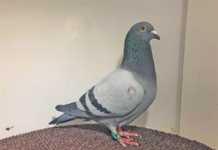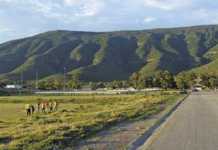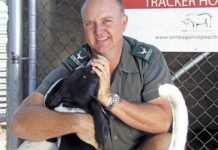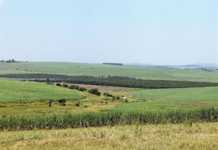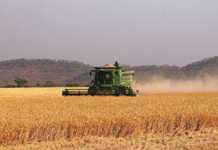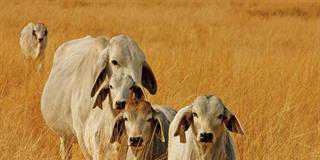“While it was raining cats and dogs in the Free State you could set the veld alight in Cathcart”, recalls Dan Kriek, vice-president of Free State Agriculture, and a South Devon breeder, after a visit to fellow cattle breeder John Miller in the Cathcart district during the parched month of March 2010.After returning to his farm near Tweeling in the Free State, Dan immediately got to work.
Within weeks, Free State farmers pledged about 800 round bales, 100t of maize, along with grazing for 100 head of cattle to their upper Cathcart counterparts. “That’s just the way we are,” says Dan. “We did it because we know what those okes are going through.”
Farmers make drought relief happen
Back in the drought-stricken Cathcart, the local farmers association secretary, and farmer’s wife, Janine Cotterrell, realised action was desperately needed. “I enjoy making things happen. It’s much easier than sitting around waiting for someone else to help you,” she says. After hours on the phone, sourcing transport companies and liaising with Free State farmers willing to donate feed, the trucks eventually started arriving in Cathcart.
The generosity of the Free State farmers knew no bounds, with donations from Villiers, Cornelia, Van Reenenskop, Skurwekop, Riversdal, Graskop, Tweeling and Reitz. To date 544 eragrostis bales sourced by Dan Kriek arrived in Cathcart (with more than 150 still to come), along with 112t maize (with 10t still to come), costing farmers about R500/t for maize and R320 for a round bale, incl VAT.
This price will be reduced significantly, says Janine, when the last loads are delivered and donations towards travel costs can be assessed. These include R10 000 from the Klaassmits Farmers Association in the Queenstown area, another R10 000 from the Sterkstroom Agricultural Union and a pledge of R5 000 from the Skurwekop Farmers Association in the Free State. BKB Louwid in Frankfort also supplied a truck to transport 16t maize to Cathcart.
“The generosity of farmers has been amazing,” says Janine, who’s quick to assure Free State farmers that one day Cathcart farmers will again be in a position to support them. “If they ever need help, the first people they’ll phone will be us, and we’ll be there for them,” she says.In fact, Janine is perpetuating a legacy of support between farmers of the two provinces during times of drought.
It’s a reciprocal relationship Ernest Pringle, Bedford farmer and Agri EC president, can vouch for. “The Free State farmers had a good season last year and were extraordinary generous,” he says. “I remember some years back in the 1980s when we were donating fodder to them. Farmers are like that. There’s nothing like a severe drought for really getting sympathy from other farmers. We’ve all been there.”
A lack of state support
As for the state’s involvement in alleviating the plight of the Eastern Cape’s commercial farmers, it’s very difficult to get any idea of what’s happening. When information is received, one gets the distinct feeling that no one really knows what’s going on. What Farmer’s Weekly was able to piece together goes something along the following lines:Yvonne Matsheketwa, spokesperson for the Eastern Cape agriculture department, is emphatic that the department initially applied for R101 million from the agriculture department for the 2009/10 financial year.
In the end, only R20 million was allocated to the department in late 2009, an amount intended to service both the 2009/10 to 2010/11 financial years. But when applications for drought relief amounted to more than R50 million in the Eastern Cape, the department realised some triage was required, with its paltry funds going to the neediest first.
How were the needy identified?
“This was done through physical identification by staff members and the use of the satellite imagery which determines the driest areas,” explains Matsheketwa. “After this process, a total of 1 165 applicants received letters of assistance. The second and last qualifying group are farmers who are also experiencing drought conditions, but not as badly as the first group. Letters of assistance will also be issued to them.”
These drought relief funds have not been effectively released by the department through designated cooperatives to service farmer’s debts with feed suppliers and transport companies. By and large farmers were left to foot the bill while waiting – in vain, as it turned out – for the first agreed-upon payouts in March 2010.For example, early in 2010, Free State Agriculture partnered with Agri EC and the Milk Producers Organisation (MPO) Eastern Cape to distribute donated Free State feed to various drought-stricken districts in the Eastern Cape, including the Tsitsikamma, East London and Steytlerville areas.
In fact, Janine was able to manage the organisation of 147 bales of fodder and 64t of maize (of which 12t was purchased at a reduced rate to fill a truck) through this initiative for members of the Upper Cathcart Farmers Association (UCFA) in the belief that the transport costs would be subsidised by the R20 million made available to the department. But not a cent has made its way to UCFA members yet, says Janine. There’s little hope among UCFA farmers that transport costs will ever be subsidised.
“We were hoping there would be some kind of subsidy to get the stuff here and we haven’t come right with that at all,” says Bobsey Hart of the farm Hopewell. Fellow farmer John Miller says he’s simply lost hope that drought relief funds will ever reach UCFA members.“The government doesn’t seem to care about agriculture – and especially commercial farmers,” he adds. “I think we’re last in the queue and we’re not going to get any relief. It’s got to pass through many hands before it gets to us.”
Coping with a prolonged drought
Cracking mud in empty stock dams is a common sight in the Upper Cathcart region. And farmers are making the most of the situation by removing sediment build-up from dry dams. Local farmer Barry Armstrong, for example, has already cleaned more than 20 dams on his farms.Like the area’s water resources, the region’s grazing has also been depleted, with three years of poor spring and summer rains forcing a number of farmers to sell and move stock. Stephen and Janine Cotterrell have been forced to sell 1 000 sheep in the past year, while John Miller sold 500 sheep and moved 70 heifers to grazing on Dan Kriek’s farm in Tweeling in the Free State.
Furthermore, the ability to grow green feed in the upper Cathcart area is now mostly limited to farmers able to irrigate from the Klipplaat River, charged by fortuitous winter snowfall in the Amatola mountains.As for those living away from the Klipplaat, their ability to grow feed has all but been neutralised as irrigation dams have run dry. Bobsey Hart showed Farmer’s Weekly a dam on Hopewell that is dry for the first time since he began farming on the family farm in 1986. “This dam has a surface area of 6,5ha. I haven’t been able to irrigate from it for four months,” he says.
“You get into a frame of mind in which you just have to accept you need to buy the fodder to keep the stock going.” In fact, he’s so desperate that he reverted to stripping the fleshy leaves of the sisal tree (garingboom) to mix into feed for stock that includes 6 000 ewes and 800 head of cattle. “But feeding animals is going to get to the point where it’s just not viable,” he says.
Contact Janine Cotterrell on 045 843 2283 or 083 279 0874.

